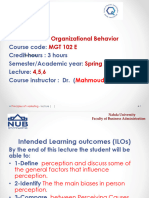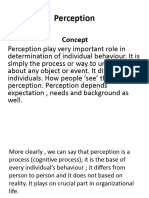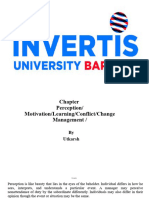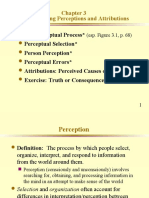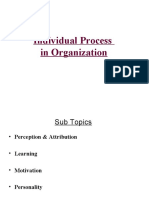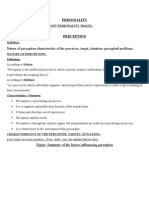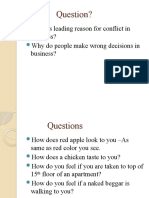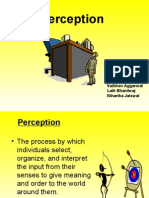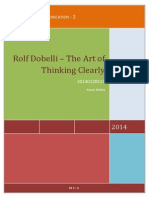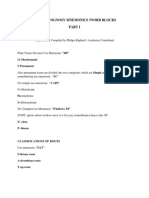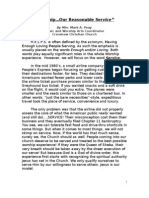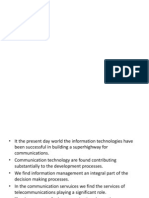Perception
Shubhra P Gaur
�Take aways from the exercise: The subjectivity of perceptions
from the witnesses statements/jurys inferences
We see what we want to see: Same information is likely to be used for execution and acquittal, suggesting that otherwise neutral information is inter connected with our unique experiences in support of our stance/decision. Halo effect: overall opinion of the person impacting further description Perceptual set-previously held beliefs: Lower socio eco status people and crime are related and Misery of debt is a common cause of murder/suicide Highlight the stereotypes of the witnesses and jury members which prevents them from questioning their own inferences / witnesses statements. Young are impulsive.
� What is the difference between perception and sensation
� Sensation deals with very elementary reception of external or internal stimuli that is determined largely by physiological functioning Perception is much more broader and complex. It is a process or filter that can be defined as a complicated interaction of selection, organization and interpretation
�Stages in the perceptual process
Receiving Selecting Organizing Interpreting Checking Reacting
�Selection
External Factors Intensity Size Contrast Movement Repetition Familiarity Novelty Internal Factors Psychological need Background Learning & Experience Personality Self acceptance
�Organizing
Grouping
Similarity-background Proximity-a department, a team Closure-of incomplete info
Figure-ground-figure is in focus Perceptual constancy- Tendency to stabilize perceptions so that contextual changes do not affect them. Helps to perceive similar problems with same perspective even if context changes.
�Factors which influence interpreting
Perceptual set-Previously held beliefs Stereotyping-opinion about a particular group The halo effect-opinion/ impression formed about a single person based on one or two favourable / unfavourable characteristics Perceptual defense-data conflicting with ones beliefs are rejected Contextual factors- interpersonal, background, organizational climate
�In Conclusion
Perception is about several things-situations, events, persons, objects , causes. Check before responding Identify errors in perception and rectify them
�Periodically remind yourselves that
Perception is a unique interpretation of reality not an exact replica of reality.
�Social Perception
Process of interpreting information about another person
�Characterstics of the perceiver
Psychological need/mood Background Learning & Experience Personality/Self concept Familiarity with the stimuli (situation/persons involved) Cognitive structures-attitudes and beleifs
�Characteristics of the target
Physical appearance including attractiveness Verbal Communication Non verbal communication
�Characteristics of the situation
Context Strength of the cues in the situation
�Barriers to accurate social perception
Selective perception-tendency to choose information that supports our viewpoint Stereotyping-generalization about a group of people First impression Projection that others are similar to us and that they have similar beliefs, values etc. Halo Effect
�Fundamental Attribution error
Underestimating situational causes and overestimating internal factors when attributing causes for negative events in others case Overestimating situational causes and underestimating internal factors when attributing causes for negative events in ones own case
�Kelleys Attribution theory
Consistency
yes
Does the person always behave like this in this situation? Distinctiveness
yes
situation
yes
Does the person behave differently in diff situations? Consensus
no
Internal
yes
Do others behave similarly in this situation?
no










